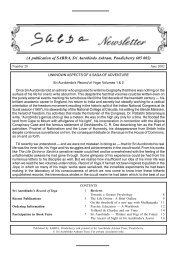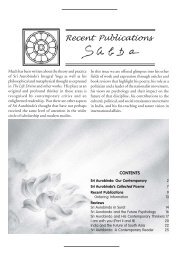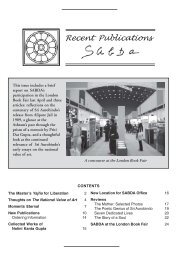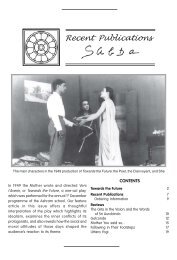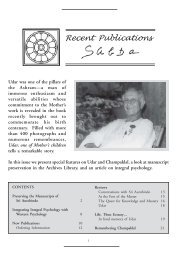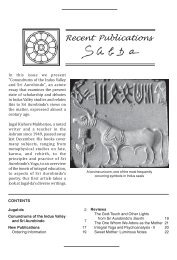Recent Publications - Sabda - Sri Aurobindo Ashram
Recent Publications - Sabda - Sri Aurobindo Ashram
Recent Publications - Sabda - Sri Aurobindo Ashram
Create successful ePaper yourself
Turn your PDF publications into a flip-book with our unique Google optimized e-Paper software.
Reproduced from SABDA <strong>Recent</strong> <strong>Publications</strong>, December 2008<br />
<strong>Recent</strong> <strong>Publications</strong><br />
The new book <strong>Sri</strong> <strong>Aurobindo</strong> <strong>Ashram</strong>: The Story of the Main Building tells the captivating story<br />
of the block of four houses where <strong>Sri</strong> <strong>Aurobindo</strong> and the Mother lived for more than fifty years.<br />
Our lead article features some photographs from the book and reminiscences from some sadhaks<br />
who settled in the <strong>Ashram</strong> in the 1920s, 1930s, and early 1940s.<br />
The <strong>Ashram</strong> Main Building, 1947-48<br />
1
The Story of the <strong>Ashram</strong> Main Building<br />
One of the publications featured in this issue<br />
is a new book about the <strong>Ashram</strong> main<br />
building, the block of four houses where<br />
<strong>Sri</strong> <strong>Aurobindo</strong> and the Mother lived for more than<br />
fifty years. Concerned almost exclusively with the<br />
physical structures, <strong>Sri</strong> <strong>Aurobindo</strong> <strong>Ashram</strong>: The Story<br />
of the Main Building traces its history from the time<br />
<strong>Sri</strong> <strong>Aurobindo</strong> and the Mother moved to the Library<br />
House on 25 October 1922, paying as rent the then<br />
handsome sum of one hundred rupees per month.<br />
recreation of an atmosphere from the years when the<br />
Mother’s daily contact with the disciples took place<br />
within the <strong>Ashram</strong> compound. In this context we<br />
asked a few sadhaks to share some memories from<br />
those days—memories that contribute to the story<br />
of the <strong>Ashram</strong> Main Building.<br />
First Impressions<br />
Robi Ganguly came to the <strong>Ashram</strong> in 1941 when he<br />
was just ten years old and recalls that “my first<br />
impression was of<br />
beautiful flowers, the<br />
fragrance of flowers.<br />
There was something<br />
wonderful as I entered<br />
the <strong>Ashram</strong>.<br />
Everything became<br />
cool; there was a very<br />
cool feeling. I loved it.<br />
As a child I didn’t<br />
analyse it in my mind,<br />
but that feeling was<br />
there right from the<br />
first day.”<br />
The Library House, Rosary House, and Meditation House 1922-29<br />
Soon the Rosary House and the Secretariat were<br />
acquired and finally the Meditation House, into<br />
which they moved on 7 February 1927. Thus a small<br />
world was created within the compound walls of these<br />
now connected properties—a world that was the very<br />
centre of the lives of all the sadhaks.<br />
While the book focuses on the renovations,<br />
reconstructions, alterations and additions to the<br />
structure of the <strong>Ashram</strong> main building through a<br />
combination of text, quotations from letters and other<br />
documents written during those early years, detailed<br />
graphic explanations, drawings and diagrams, and<br />
many old photographs, an ancillary effect is the subtle<br />
Tara-ben Patel, who<br />
settled in the <strong>Ashram</strong><br />
in 1930, remembers<br />
that the Mother was<br />
very strict about only<br />
having one gate open, and that everyone entered and<br />
left by the gate to the Library House. As soon as she<br />
passed through that gate she would “fall into<br />
meditation”—no effort was needed; the atmosphere<br />
was so peaceful, so intense.<br />
Chitra Sen, who came to settle here in the early 1940s,<br />
when she was a young girl, remembers that when<br />
she entered the <strong>Ashram</strong>, “I used to feel something<br />
passing through me. It was something you may<br />
describe as being more dense than the atmosphere.”<br />
She went on feeling it as she passed by all the rooms<br />
where the sadhaks were working in such a<br />
concentrated state.<br />
2
As Chitra-di was too young at first to attend the<br />
evening meditation, she sat with her sister under the<br />
Transformation tree that used to grow under the<br />
window of <strong>Sri</strong> <strong>Aurobindo</strong>’s room in the Library<br />
House, where the rockery is now. “There I used to<br />
sit while the meditation was going on. And now I<br />
understand that I had some experience. I was sitting<br />
there, but as if I didn’t have a mind at all; no thoughts<br />
came. For some time I sat like that. As I was a child,<br />
these things came spontaneously.” In this photo one<br />
can clearly see the Transformation tree which Chitradi<br />
describes.<br />
The Library House 1922-29<br />
Victoire’, which two or three persons would then<br />
repeat. That was the Window Darshan.” He also<br />
recalls seeing Shuddhananda Bharati, who stayed in<br />
the room that is now the Bulletin office, going each<br />
day to the Mother during Vegetable Darshan at about<br />
noon. She would come down from her room on the<br />
first floor by the staircase near Nirodbaran’s room to<br />
see the vegetables that had been brought for the<br />
dining room. “The Mother would throw tomatoes<br />
to everyone. And you had to catch them!”<br />
Beginning on page 148 of the book there is a<br />
description of the Mother’s terrace walk, which took<br />
place shortly after the Window Darshan. She would<br />
come out onto the terrace south of the Salon and<br />
stand there briefly before going up the staircase to<br />
the top terrace for her walk. A diagram on page 149<br />
clearly marks the route she sometimes took. Several<br />
photos also show disciples in the <strong>Ashram</strong> courtyard<br />
having the Mother’s darshan as she took her walk.<br />
Chitra-di remembers that during this Terrace<br />
Darshan “Dilip-da [Dilip Kumar Roy] would stand<br />
there by the palm tree in front of Purani’s room. As<br />
the Mother was going up the staircase she would<br />
stop at this small landing, turn, and smile down at<br />
Dilip-da. Her grace and love—everything was flowing<br />
through that smile. It was something to see. I still<br />
remember that.”<br />
Darshans<br />
Many people are familiar with the Balcony Darshan<br />
that the Mother used to give in the early morning<br />
from the balcony of Pavitra’s room, but there were<br />
other opportunities later in the morning for the<br />
disciples (and for the children who roamed freely<br />
about the compound) to have darshan of the Mother.<br />
At about nine or nine-thirty the Mother would open<br />
the far right and far left windows of her room, known<br />
as the Salon, where she was spending most of the<br />
day. Robi-da remembers that when she opened the<br />
first window “someone would call out ‘Victoire à la<br />
Douce Mère’. It was usually Anilbaran, or perhaps<br />
Madangopal. Anyway, there was keen competition<br />
on who could say it first. And the moment she<br />
opened the next window they would say ‘Au Divin<br />
The terrace south of the Salon where the Mother used to come<br />
and stand before going to the second floor for her walk. The small<br />
landing Chitra-di mentions can be seen midway up the staircase<br />
3
Service and the Photo Section. Robi-da has described<br />
one of these study rooms: “It was a very small room,<br />
but there was a large table there, and then one, two,<br />
three, four, five, six, seven … eight chairs were there—<br />
I still remember. On each side there were two chairs.<br />
And it was difficult to get in if you were late because<br />
near the door the chair had already been placed and<br />
the table almost filled the room.” Eventually this<br />
room could no longer be used for classes as there<br />
were just too many children.<br />
Disciples in the <strong>Ashram</strong> courtyard during the<br />
Mother’s terrace walk<br />
Studies<br />
Naturally the sadhaks interviewed for this article were<br />
children when they came to the <strong>Ashram</strong> in the 1930s<br />
and early 1940s, and they shared some reminiscences<br />
of the type of schooling that took place inside the<br />
<strong>Ashram</strong> main building. Suprabha Nahar settled in<br />
the <strong>Ashram</strong> in 1941, when she was eleven. There<br />
was no school as yet, so the Mother arranged for some<br />
of the Nahar children to be taught at home. Her<br />
elder sister Sujata had been assigned the work of<br />
teaching the younger siblings French. But, as<br />
Suprabha-di recalls, “at home you play and talk and<br />
hardly study at all. So one day, Didi [her elder sister<br />
Sujata] gave me an idea. I was standing in the <strong>Ashram</strong><br />
courtyard, and Chandulal was going to his room<br />
when he asked me, ‘How is your French going on’ I<br />
said, ‘Not much progress, why don’t you teach me’<br />
He agreed and started taking our French class in his<br />
room on the ground floor. He used to send our<br />
notebooks to the Mother.” Pavitra also taught some<br />
subjects, in the rooms that now house the Reception<br />
Anu Purani was educated primarily by her father A.<br />
B. Purani, who gave her classes in Gujarati, English,<br />
and maths in one of his two rooms inside the <strong>Ashram</strong><br />
main building. “My father saw that I was extremely<br />
restless while doing my lessons, so he said, ‘Why<br />
don’t you learn to play the veena’ He went off into<br />
town and found one lady who was teaching the veena.<br />
It was so hard, you know, you sit cross-legged and<br />
keep the veena there and then turn your hand<br />
around—it is quite difficult. He saw that I was<br />
avoiding it, and he told me it was very easy, ‘Why do<br />
you escape See, I can do it.’ For my sake he learned<br />
it and he made me do it.” The symbolic name given<br />
by the Mother to Purani’s room was Agni and his<br />
study, the room in which Anu-ben did her lessons<br />
and practised the veena, was called Peace in the<br />
Physical. Both these rooms are located off the<br />
courtyard which leads to the staircase going up to<br />
<strong>Sri</strong> <strong>Aurobindo</strong>’s and the Mother’s rooms, and perhaps<br />
they sometimes overheard Anu-ben diligently<br />
practising her music.<br />
Studies, of course, meant that homework must be<br />
done, and we learn that these young students bent<br />
their heads over their notebooks in the most unlikely<br />
places. Robi-da said that many of the children did<br />
their homework in Dyuman’s room while waiting<br />
for the Mother to come down for evening meditation<br />
in the late forties. Chitra-di remembers doing her<br />
homework while she sat in the flower room, which<br />
was then located in what later became Pujalal’s room.<br />
The Mother had given her the work of keeping all<br />
the trays and dishes on which flowers had been offered<br />
and returning them to their owners. She kept them<br />
all neatly in a cupboard and, while she sat there, did<br />
4
her homework and sometimes watched the younger<br />
children, like Aster and Kittu, playing in the open<br />
courtyard. By this time, in 1943, the old flower room<br />
in the centre of the courtyard had been taken down<br />
and in its place there was a long rectangular structure<br />
with fern pots on top (where the Samadhi was later<br />
built). In this photo one can see some children<br />
standing by this structure, under the branches of<br />
the Service Tree.<br />
Robi-da remembers how<br />
they used to play hopscotch,<br />
marbles, and other games<br />
during the Terrace Darshan<br />
and that they made a lot of<br />
noise, because the number of<br />
children had grown. One<br />
day the Mother called<br />
Chandulal and told him it<br />
was becoming too noisy<br />
during the Terrace Darshan<br />
so there must be a school to<br />
keep the children occupied<br />
during the morning hours.<br />
“That is how the school<br />
started. I don’t know how many people know about<br />
it, but that is what Chandulal told me.” And<br />
Chandulal said that the Mother had asked him to<br />
design benches for the school. One afternoon, Robida<br />
recalls, three different specimens of benches were<br />
kept in the courtyard just below the terrace of<br />
Dyuman’s room. He and a few others were there when<br />
the Mother came out on the terrace and asked them<br />
to sit and try the benches. “And I still remember I<br />
told the Mother, ‘This bench is very comfortable for<br />
sleeping!’ So one of the benches was chosen and<br />
Chandulal got them made for the opening of the<br />
school on 2 December 1943.”<br />
Meditation and Pranam<br />
At this time, during the early forties, the Mother<br />
held meditation for the sadhaks in the Meditation<br />
Hall every evening at about seven o’clock. She would<br />
come down the staircase, stop halfway, place her hand<br />
on the banister, and the meditation would begin. It<br />
would last ten to twenty minutes, sometimes longer.<br />
People had their customary places and used to gather<br />
ahead of time; some would meditate and others would<br />
just wait quietly for the Mother’s arrival. After the<br />
meditation people were allowed to go up to the top<br />
of the staircase, to the small passage just behind the<br />
door, for pranam. People were assigned different days<br />
on which they could go up. Chitra-di describes how<br />
the Mother used to stand there: “One of the shutters<br />
would be closed. And she stood behind it, so when<br />
we went to her it was absolutely private. Between<br />
where the Mother stood and the Salon door there<br />
was a low table with flowers on it. Champaklal would<br />
stand by the side there and help by taking or carrying<br />
the flowers.”<br />
From 1931 to 1938, the sadhaks offered pranam to<br />
the Mother in the Meditation Hall downstairs. The<br />
Mother sat on a low chair near the door to Amrita’s<br />
room, where now the large painting of <strong>Sri</strong> <strong>Aurobindo</strong><br />
and the Mother is kept. The sadhaks would sit where<br />
the Mother’s bed is now kept. Suprabha-di says that<br />
her sister Sumitra remembers attending this pranam<br />
quite clearly. “Everyone had to go in order to the<br />
Mother. Once, after waiting and seeing so many<br />
people going for pranam, Sumitra-di could not contain<br />
herself and just went forward out of turn and made<br />
pranam to the Mother. She got a scolding from my<br />
uncle Udaysingh, but the Mother later told my father<br />
Prithwisingh that she liked her spontaneity.”<br />
5
Toward the end of the book there is a diagram<br />
showing the placement of furniture and location of<br />
rooms on the ground floor of the Meditation House<br />
and the first floor of the New Secretariat. Here you<br />
were sitting just opposite, where they have now the<br />
washing area for flowers. I was sitting there and<br />
straight in front of me stood the Mother. What a<br />
voice—it was so overpowering! When she gave a<br />
can clearly see the passage at the top of the staircase<br />
(marked G) where people went to the Mother for<br />
pranam as well as the seat (marked 1) used by the<br />
Mother for pranam in the Meditation Hall<br />
downstairs.<br />
Later, when more and more people came, the evening<br />
meditation was shifted outside. The Mother would<br />
come out of the south door of the Salon, move to the<br />
front edge of the terrace above Dyuman’s room, and<br />
stand there to hold meditation for those who had<br />
gathered in the courtyard. Chitra-di also remembers<br />
the day when the Mother, from this location, read<br />
out a message marking the end of the Second World<br />
War. It was 16 August 1945, and “we knew that the<br />
Mother would be reading something, so that day we<br />
message it was always in a different voice.” This was<br />
the prayer that the Mother read out on that day:<br />
The victory has come, Thy victory, O Lord,<br />
for which we render to Thee infinite<br />
thanksgiving.<br />
But now our ardent prayer rises to Thee. It<br />
is with Thy force and by Thy force that the<br />
victors have conquered. Grant that they do<br />
not forget it in their success and that they<br />
keep the promises which they have made to<br />
Thee in the hour of danger and anguish.<br />
They have taken Thy name to make war;<br />
may they not forget Thy Grace when they<br />
have to make the peace.<br />
6
Work<br />
Tara-ben Patel was eighteen years old when she settled<br />
in the <strong>Ashram</strong>. In those days everyone took up a work<br />
assigned by the Mother. Tara-ben and her elder sister<br />
Lila-ben were asked by the Mother if they would<br />
like to do some cooking. Lila-ben replied that they<br />
were just village girls from Gujarat and didn’t know<br />
any dishes outside of their village cooking. When<br />
the Mother offered to teach them, they happily<br />
agreed, and soon took up the work in the tiled-roof<br />
kitchen that stood in the centre of the courtyard.<br />
You can see this<br />
building in the photo<br />
here, with the<br />
branches of the<br />
Service Tree resting<br />
on its roof.<br />
The sisters would<br />
prepare a variety of<br />
dishes after looking at<br />
the available<br />
vegetables. When<br />
once asked by the<br />
Mother to repeat a<br />
p a r t i c u l a r<br />
preparation that she<br />
had liked, Lila-ben<br />
replied that she<br />
could not at all<br />
remember how she<br />
made it. She had<br />
cooked it while in a<br />
trance-like state of inspiration, thinking only of <strong>Sri</strong><br />
<strong>Aurobindo</strong> and the Mother.<br />
Norensingh Nahar first visited the <strong>Ashram</strong> in 1936<br />
when he was a boy of sixteen. After settling here, he<br />
joined the construction work at Golconde in 1939,<br />
helping to bend steel rods for the reinforced concrete.<br />
Later, in 1940, the Mother gave him a place to grow<br />
vegetables in the small Prosperity courtyard behind<br />
the Library House. He even tried to grow paddy<br />
there, without much success. Although Norensinghda<br />
is best known for his work on the <strong>Ashram</strong> stamp<br />
collection, he relates how the Mother had also put<br />
him in charge of the fruits, when they were being<br />
washed in Pavitra’s laboratory upstairs, before the<br />
Fruit Room was built in 1948. The laboratory is a<br />
small room just to the right of the staircase on the<br />
first floor of the new Secretariat, and it was in this<br />
room that lotions, soaps, pastilles, and other items<br />
were prepared for <strong>Sri</strong> <strong>Aurobindo</strong> and the Mother<br />
under Pavitra’s direction. Norensingh-da recounts:<br />
We got papayas from Ambabhikshu’s garden<br />
and from Bangalore came tomatoes and oranges.<br />
So we used to wash them with permanganate<br />
and keep them<br />
separately. <strong>Sri</strong><br />
<strong>Aurobindo</strong> especially<br />
liked the papayas<br />
from a particular tree.<br />
Ambabhikshu used<br />
to write numbers on<br />
the papayas,<br />
indicating from<br />
which tree they came.<br />
So when we saw that<br />
particular number,<br />
say 36, on any<br />
papaya, we’d wash it<br />
carefully and specially<br />
keep it apart for <strong>Sri</strong><br />
<strong>Aurobindo</strong>. In those<br />
days, in the corner<br />
near where the<br />
Samadhi now is,<br />
there was a tree with<br />
custard apples<br />
(ramphal) that both <strong>Sri</strong> <strong>Aurobindo</strong> and the<br />
Mother liked very much. At Santal House there<br />
was a mango tree, very big. <strong>Sri</strong> <strong>Aurobindo</strong> used<br />
to like the mangoes from that tree.<br />
In the early morning the Mother would arrange the<br />
fruits in baskets and from there the baskets were<br />
distributed to the sadhaks. When the quantity of<br />
fruit became too much to handle in the laboratory,<br />
the Mother thought of having a fruit room, which<br />
was then built on the terrace of the Cold Storage<br />
block. Eventually Norensingh-da gave up this fruit<br />
room work and Ravindra, who was already looking<br />
7
after the Cold Room, where<br />
almonds, dried fruit, and<br />
other items were stored,<br />
took over. These photos<br />
show the completion of the<br />
ground floor of the Cold<br />
Storage block in 1935 and<br />
the Fruit Room in 1948.<br />
In the photo below you can<br />
see the very long terrace of<br />
the Cold Storage block that<br />
extended to the new Fruit<br />
Room. Anu-ben recalls how<br />
the Mother had the idea to<br />
Cold Storage block<br />
Fruit Room<br />
make here two rooms for Ravindra, and that she<br />
particularly wanted the construction of these rooms<br />
to be done only by <strong>Ashram</strong>ites. The first floor of the<br />
Cold Storage block was completed in 1958, and the<br />
Mother attended the opening of the new rooms.<br />
Other sections of the book recount the story of the<br />
Samadhi, the construction of the Mother’s rooms on<br />
the second floor, and the symbolic names of rooms<br />
in the <strong>Ashram</strong> main building given by the Mother<br />
during the years 1928–32. The Publication<br />
Department/SABDA’s Service branch takes its name<br />
from the one given by the Mother to its main room.<br />
All the sections of the book, filled with old<br />
photographs, letters, diagrams, and excerpts from<br />
interviews with sadhaks, are woven into a<br />
compelling narrative that captures not just how<br />
the <strong>Ashram</strong> main building developed structurally,<br />
but also something of the special atmosphere of<br />
the <strong>Ashram</strong> in its early years. As Robi Ganguly<br />
so aptly describes his impression, “When I hold<br />
the book, I almost get back the olden days. That’s<br />
what I like about it. Apart from the research that<br />
has gone into it, it has an atmosphere of the<br />
<strong>Ashram</strong>. And one feels the spirit behind the<br />
work, the attitude with which the whole work<br />
has been carried out. It is the attitude that really<br />
counts.”<br />
To end these recollections about the story of the<br />
<strong>Ashram</strong> main building, we have a comment from<br />
Amal Kiran [K. D. Sethna], who celebrated his 104 th<br />
birthday in November 2008. He first came to the<br />
<strong>Ashram</strong> more than eighty years ago, in 1927, earlier<br />
than any other current <strong>Ashram</strong>ite. When <strong>Sri</strong><br />
<strong>Aurobindo</strong> <strong>Ashram</strong>: The Story of the Main Building<br />
came out in July, he was given a copy to look at. He<br />
pronounced it a “handsomely produced volume” and<br />
added, with a sense for language and history that is<br />
notable in much of his writing, that when he first<br />
came to the <strong>Ashram</strong> in 1927 [the Meditation House<br />
had only been acquired earlier that year], it was the<br />
8
western wing, or the Library House, which was known<br />
as the <strong>Ashram</strong> “main building”. This observation<br />
reminds us that it was in 1922, when <strong>Sri</strong> <strong>Aurobindo</strong><br />
and the Mother moved into the Library House, that<br />
the history of the <strong>Ashram</strong> main building began. This<br />
book tells the story.<br />
Note: Anu Purani was interviewed for this article on<br />
9 August 2008, less than two months before she passed<br />
away. Anu-ben was a dancer, choreographer, editor,<br />
Hindi teacher, and dedicated administrator and teacher<br />
at the Udavi village school.<br />
Excerpt from the book<br />
The Meditation House, where <strong>Sri</strong> <strong>Aurobindo</strong> and the Mother moved on 7 February 1927, was the last of the four houses<br />
to be taken on rent and the first one to be purchased. A letter by Barin Ghose, <strong>Sri</strong> <strong>Aurobindo</strong>’s youngest brother,<br />
describes the Mother’s inspection of the Meditation House:<br />
Soon after coming back from Calcutta I heard that the house adjoining ours was vacant. I don’t know what impelled me<br />
to go and see it. I casually mentioned it to Mother Mirra. She wanted to see it too. We did not know at the time that this<br />
house would be <strong>Sri</strong> <strong>Aurobindo</strong>’s abode and the very centre of the <strong>Ashram</strong> buildings. Mother might have felt something<br />
of the kind but she did not give us any inkling until I actually took her there.<br />
A Bengali young man from<br />
Hyderabad (the Nizam’s capital)<br />
was in correspondence with me<br />
at this time on Yoga and kindred<br />
matters. He mentioned one<br />
Ibrahim in his letters, a young<br />
Mahomedan idealist, who<br />
wanted to come to Pondicherry<br />
and take up Yoga. Ibrahim<br />
subsequently wrote to me and<br />
actually came for a short visit. He<br />
was stout, fair, very quiet and<br />
unobtrusive, with large lustrous<br />
eyes and a great hankering for<br />
things spiritual. He went away<br />
promising to come later,<br />
renouncing the world for good and<br />
sit down at the feet of the great<br />
Master to learn Yoga.<br />
The Meditation House 1922-29<br />
As soon as the key of the new<br />
house was procured, the Mother<br />
went to inspect it. So far as I remember, it was a sweet and clear morning with white fleecy clouds suspended in the<br />
blue sky. Ibrahim had returned by this time. He also accompanied us. As Mother Mirra went up the grand staircase of the<br />
new house, she fell into a trance. Gently she entered the hall, looked about in her peculiar dreamy and absorbed way.<br />
Turning to me with her luminous mystic smile, she said, “I see untold wealth here, Dara has brought it with him.” She<br />
moved about the house in a tense, indrawn state.<br />
Ibrahim was ... renamed Dara (after the eldest bother of Emperor Aurangzeb) by the Master. She [the Mother] at once<br />
began negotiating for the purchase of the house. The owner wanted as much as Rupees 14,000, an exorbitant sum for<br />
it. Mother said money wasn’t of any consequence as this house meant so much for the future of the colony. So it was<br />
purchased and repaired for <strong>Sri</strong> <strong>Aurobindo</strong> to live in.<br />
9



